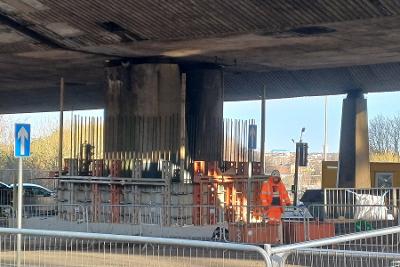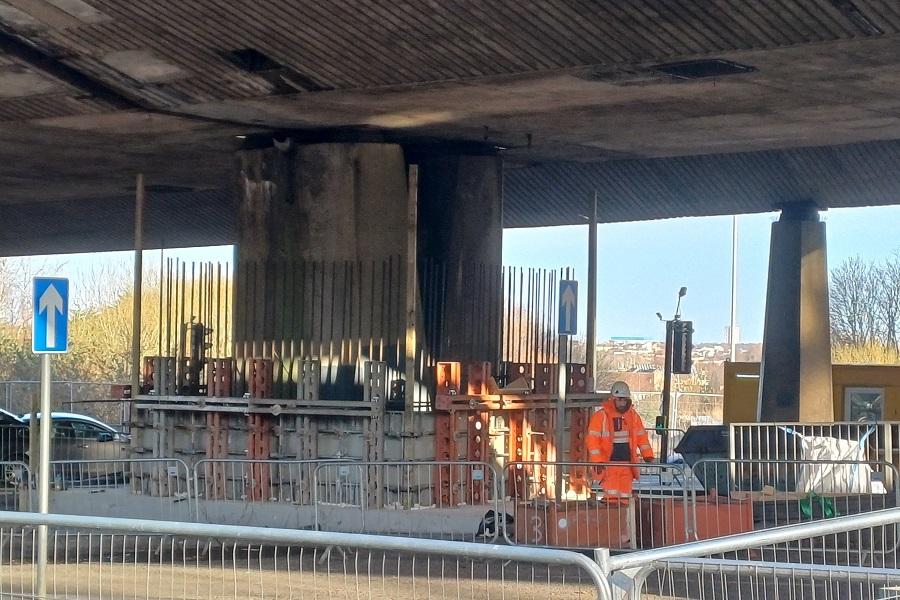Flyover update - works have started on extra concrete to support structure

Engineers have begun work on providing support to two central pillars under the Gateshead Highway flyover.
Gateshead Council has hired specialist contractors to encase the pillars (known as piers) in concrete, as an interim measure to enable the removal of the temporary props currently beneath the flyover's structure.
The council's longer-term plan is to work towards demolition, subject to Cabinet approval. Well over £1m has been spent to date, to manage the closure of the Gateshead Highway and protect the public, including hiring the emergency propping required, fencing and security, increased monitoring, and out of hours staff, contractor and consultant costs.
The concrete work will take some weeks to complete - and for the concrete to reach full strength. The curing of the concrete is weather dependent - colder temperatures will mean the process takes longer.
The introduction of the concrete reinforcement, however, does not completely eliminate the risks around the flyover, so the council will still monitor the structure closely, and it will not be re-opening the upper deck to traffic.
The expectation is that the props will be removed in mid to late March - and this should also allow the re-opening of the Sunderland Road bus and cycle lane which runs beneath the flyover and this will allow a more direct and level route to the town centre for pedestrians in the adjoining housing.
Contractors have already removed some concrete panels on the side of the flyover structure to help remove any potential risk.
Councillor Martin Gannon, Leader of Gateshead Council, said: "Our officers have been working hard to progress this huge and complicated project and minimise disruption whilst protecting safety.
"Since December 13th,we've had to get propping in place, get designs organised for the concrete reinforcement, plan the demolition programme, and put together proposals for what comes after demolition.
"Our teams moved rapidly to put diversions in place and ensure regular communications with those affected.
"We are also continuing to talk to partners to bring forward a deliverable and funded plan not just for the roads, but for the regeneration of the town centre and wider area around the flyover."
Beyond the concrete reinforcing work, Gateshead Council and its specialist contractors and engineers are working to bring forward a plan to safely demolish the flyover.
The project is highly technical, given the design of the flyover and that it was built using post-tensioned concrete.
Councillor Gannon added: "We know it must be frustrating for town centre businesses, to have uncertainty around road transport, but we can assure them departments across the council are working hard to bring plans forward rapidly.
"Our data shows traffic levels are not far off normal around our town centre roads, and we do have a town centre manager working to support businesses and market the centre
"A high number of town centre visitors arrive by public transport - both Metro and buses, so it's important we help public transport run smoothly too."

Engineers have begun work on providing support to two central pillars under the Gateshead Highway flyover.
Gateshead Council has hired specialist contractors to encase the pillars (known as piers) in concrete, as an interim measure to enable the removal of the temporary props currently beneath the flyover's structure.
The council's longer-term plan is to work towards demolition, subject to Cabinet approval. Well over £1m has been spent to date, to manage the closure of the Gateshead Highway and protect the public, including hiring the emergency propping required, fencing and security, increased monitoring, and out of hours staff, contractor and consultant costs.
The concrete work will take some weeks to complete - and for the concrete to reach full strength. The curing of the concrete is weather dependent - colder temperatures will mean the process takes longer.
The introduction of the concrete reinforcement, however, does not completely eliminate the risks around the flyover, so the council will still monitor the structure closely, and it will not be re-opening the upper deck to traffic.
The expectation is that the props will be removed in mid to late March - and this should also allow the re-opening of the Sunderland Road bus and cycle lane which runs beneath the flyover and this will allow a more direct and level route to the town centre for pedestrians in the adjoining housing.
Contractors have already removed some concrete panels on the side of the flyover structure to help remove any potential risk.
Councillor Martin Gannon, Leader of Gateshead Council, said: "Our officers have been working hard to progress this huge and complicated project and minimise disruption whilst protecting safety.
"Since December 13th,we've had to get propping in place, get designs organised for the concrete reinforcement, plan the demolition programme, and put together proposals for what comes after demolition.
"Our teams moved rapidly to put diversions in place and ensure regular communications with those affected.
"We are also continuing to talk to partners to bring forward a deliverable and funded plan not just for the roads, but for the regeneration of the town centre and wider area around the flyover."
Beyond the concrete reinforcing work, Gateshead Council and its specialist contractors and engineers are working to bring forward a plan to safely demolish the flyover.
The project is highly technical, given the design of the flyover and that it was built using post-tensioned concrete.
Councillor Gannon added: "We know it must be frustrating for town centre businesses, to have uncertainty around road transport, but we can assure them departments across the council are working hard to bring plans forward rapidly.
"Our data shows traffic levels are not far off normal around our town centre roads, and we do have a town centre manager working to support businesses and market the centre
"A high number of town centre visitors arrive by public transport - both Metro and buses, so it's important we help public transport run smoothly too."
